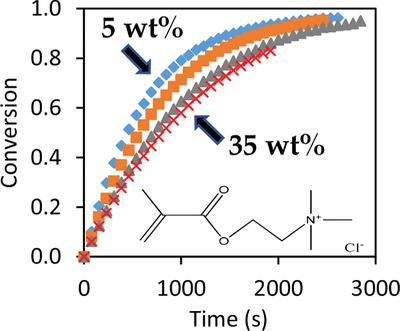当前位置:
X-MOL 学术
›
Macromol. React. Eng.
›
论文详情
Our official English website, www.x-mol.net, welcomes your
feedback! (Note: you will need to create a separate account there.)
Experimental and Modeling Investigation of Radical Homopolymerization of 2‐(Methacryloyloxyethyl) Trimethylammonium Chloride in Aqueous Solution
Macromolecular Reaction Engineering ( IF 1.8 ) Pub Date : 2019-10-09 , DOI: 10.1002/mren.201900033 Ikenna H. Ezenwajiaku 1 , Anna Chovancová 2 , Kyle C. Lister 1 , Igor Lacík 2 , Robin A. Hutchinson 1
Macromolecular Reaction Engineering ( IF 1.8 ) Pub Date : 2019-10-09 , DOI: 10.1002/mren.201900033 Ikenna H. Ezenwajiaku 1 , Anna Chovancová 2 , Kyle C. Lister 1 , Igor Lacík 2 , Robin A. Hutchinson 1
Affiliation

|
The radical homopolymerization kinetics of 2‐(methacryloyloxyethyl) trimethylammonium chloride (TMAEMC) in aqueous solution is investigated across a wide range of initial monomer contents (5–35 wt%), ionic strengths, and pH levels using an in‐situ NMR technique to track monomer consumption over the complete conversion range. Molar mass distributions (MMD) of the final homopolymers are also examined, with additional batch and semi‐batch experiments conducted in a stirred vessel. The rates of monomer conversion and polymer MMDs are dependent on initial monomer content but almost entirely independent of pH and the presence of salts, with some acceleration of rate observed for low monomer levels at very high salt concentration. To aid with the interpretation of these results, the conductivity and counterion activity of monomer and polymer mixtures are measured to determine the extent of electrostatic interactions at various levels of conversion. These results are combined with recently reported measurements of TMAEMC homopropagation kinetics to develop a TMAEMC homopolymerization model that captures the systematic decrease in rates of monomer conversion observed with increased initial monomer content during batch polymerization as well as provides a good representation of semi‐batch polymerization.
中文翻译:

水溶液中2-(甲基丙烯酰氧基乙基)三甲基氯化铵自由基均聚的实验与模型研究
使用原位NMR技术研究了2-(甲基丙烯酰氧基乙基)三甲基氯化铵(TMAEMC)在水溶液中的自由基均聚动力学,该过程涉及广泛的初始单体含量(5-35 wt%),离子强度和pH值。在整个转化范围内跟踪单体消耗。还检查了最终均聚物的摩尔质量分布(MMD),并在搅拌容器中进行了另外的分批和半分批实验。单体转化率和聚合物MMD的速率取决于初始单体含量,但几乎完全不依赖于pH值和盐的存在,在非常高的盐浓度下,低单体含量的速率有所提高。为了帮助解释这些结果,测量单体和聚合物混合物的电导率和抗衡离子活性,以确定在各种转化水平下静电相互作用的程度。这些结果与最近报道的TMAEMC均相传播动力学测量结果相结合,开发出了TMAEMC均聚模型,该模型捕获了在间歇聚合过程中观察到的单体转化速率随初始单体含量增加而系统降低的情况,并很好地代表了半间歇聚合。
更新日期:2019-10-09
中文翻译:

水溶液中2-(甲基丙烯酰氧基乙基)三甲基氯化铵自由基均聚的实验与模型研究
使用原位NMR技术研究了2-(甲基丙烯酰氧基乙基)三甲基氯化铵(TMAEMC)在水溶液中的自由基均聚动力学,该过程涉及广泛的初始单体含量(5-35 wt%),离子强度和pH值。在整个转化范围内跟踪单体消耗。还检查了最终均聚物的摩尔质量分布(MMD),并在搅拌容器中进行了另外的分批和半分批实验。单体转化率和聚合物MMD的速率取决于初始单体含量,但几乎完全不依赖于pH值和盐的存在,在非常高的盐浓度下,低单体含量的速率有所提高。为了帮助解释这些结果,测量单体和聚合物混合物的电导率和抗衡离子活性,以确定在各种转化水平下静电相互作用的程度。这些结果与最近报道的TMAEMC均相传播动力学测量结果相结合,开发出了TMAEMC均聚模型,该模型捕获了在间歇聚合过程中观察到的单体转化速率随初始单体含量增加而系统降低的情况,并很好地代表了半间歇聚合。











































 京公网安备 11010802027423号
京公网安备 11010802027423号